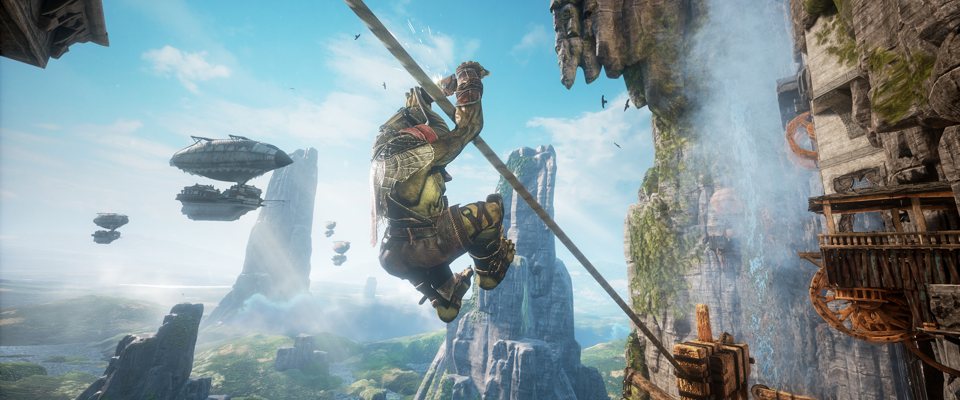Fifty years on from his daring dance of stealth and deception in the Tower of Skenash, Styx is back. Where fifty years would be a long time for you or me, it’s water off a duck’s back to the already ancient Styx, who’s just as nimble a goblin now as he was then. If anything, he’s picked up a few new tricks.
Master of Shadows was a pretty decent stealth game, all told. When games like Assassin’s Creed and Splinter Cell have gone in a more fluid, dynamic and confrontational direction, Styx stepped back to a style of game that was all about careful and considered stealth. Guards had their routines in amongst some pleasingly freeing levels, and you almost always had time to stay out of sight, observing and planning before striking and putting your plan into action.
Of course, with Cyanide not working with the same kind of budget as Ubisoft’s studios can, it did have its shortcomings. Most noticeable was how the latter parts of the game had you working through previously visited areas in reverse, but there were also more systemic flaws, whether in the rigidity of the guard patterns or simply some of the difficulty spikes along the way. Some people will also have struggled with playing the gruff and crotchety little bundle of stabbing and murder that was Styx.
Shards of Darkness certainly looks to alleviate some of these flaws, thanks in part to a larger budget. Where the original had you methodically working your way through a huge castle, and looked very similar throughout as a consequence, this game is breaking out into the wider world. The prologue level, which was used as a demonstration, had Styx working his way through a squalid looking little harbour in the moonlight, but other images show completely contrasting and more vibrantly coloured areas, from cities of the world to flying citadels.
Such visual variety is backed up by a jump to Unreal Engine 4, with the improvements to lighting that come off the back of this. However, there’s a feeling that this engine and a greater familiarity with the console hardware is also going to allow Cyanide to create some truly jawdropping vistas and large locales. The scale of Master of Shadows was already a strong point for the game, but this could be even more ambitious.
The world in which you find Styx is a very different one to that game, though. What had previously been a testy alliance between Humans and Elves was shattered by Styx’s actions, and now the traditionally “good” races are banding together in the face of the emerging Goblin threat. For Styx, however, he’s looking after himself, as he hunts for the eponymous shards that have come to be a new source of power in the world, in the wake of the permanent drought of amber.
It’s the scarcity of amber that will have come to temper some of his skills at the start of the game, but overall, Styx will become a more powerful and rounded character to play as in this game. There’s new abilities that centre around being able to clone Styx, for example, where you can throw a clone cocoon across a gap and have it grab onto a ledge on the other side, or simply use it as a scout to try and get through a tricky platforming section, before Styx makes use of his new ability to teleport to the clone’s position. Some of his other abilities have been rounded off as well, so that he can now grab and pull a guard through a window – something seemingly so obvious in hindsight.
Emphasising the scarcity of resources, there’s a new crafting system in the game, which will have you exploring more and hunting for ingredients needed to make a lock pick, an acid trap, arrows, and so on. It’s modelled after the kind of crafting that was seen in The Last of Us, with a small number of different ingredients combining in a number of different ways to make many different items. It’s a clever system to borrow, because it forces you to make choices between different things that might suit your style of play or a given situation.
Of course, it wouldn’t be fair if Styx was the only one to get new toys. The races that he’ll encounter, which now include Dark Elves and Dwarves, are more varied and more alert to the potential threat that they face. Shadows are now analogue instead of binary, changing the degree to which you can feel safe when hiding, but they’ll also hound you with flying units and try to flush you out of cover with gas bombs. Heck, some of them will even be able to smell you coming.
There’s an interesting, if potentially throwaway, move toward replayability, with level ending stats and scores that you can try to improve upon, whether it’s playing without killing enemies or making sure to collect all the items and secrets. That’s alongside the curious prospect of being able to play cooperatively online, via drop in/drop out multiplayer.
However, underneath it all, there’s the worry that some niggling issues might not be addressed. For example, there were still the same kind of rigid patrol routines on show that had a worker down tools every 20 seconds to go and get a drink of water, making him a very, very easy target for poisoning.
That’s fine, though, because Styx doesn’t need to try and bigger and better than the next Splinter Cell. It’s a stealth game that’s focussed purely on the stealth and the inherent pleasure of solving the puzzle that each room and situation presents to you.




bunimomike
“A worker down tools every 20 seconds to go and get a drink of water, making him a very, very easy target for poisoning.”
He’s just on detox, that’s all. Sheesh! :-P